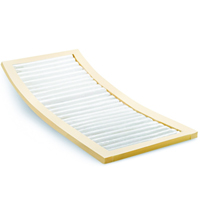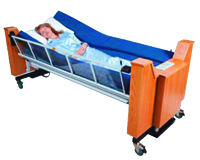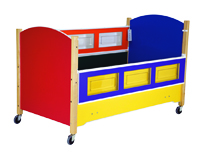
Rest Easy

Products and tips to improve your sleep and maximize energy and comfort during waking hours
It’s a catch-22: Getting a good night’s sleep is an important way for people living with neuromuscular diseases to help maximize their health and well-being. But the physical symptoms of many of these diseases can themselves limit the restfulness of sleep.
“We tend to overlook the importance of sleep; it’s so basic,” says Sharon Greenberg, an occupational therapist in the MDA Clinic at Seattle Children’s Hospital. “But getting good rest can be a real challenge for people with these diseases.”
Immobilized joints tend to get achy and uncomfortable. And although most people change positions or stretch frequently during sleep without even being aware of it, those with limited mobility can’t easily move during the night to relieve the pain and numbness that result from staying in the same spot hour after hour.
“It’s difficult for people with neuromuscular disease and difficult for caregivers who have to get up frequently to help them change position,” says Jacqueline Montes, a physical therapist and assistant professor of clinical rehabilitation and regenerative medicine in neurology at Columbia University (site of an MDA clinic) in New York City.
People who stay in the same position also risk developing pressure sores. “Sometimes patients are in a deep sleep and don’t notice the pressure, and body parts can become numb when you take away circulation for any length of time,” adds Greenberg. “Some patients don’t have a lot of padding on bony [areas], and the skin can break down pretty quickly.”
Improving sleep is usually a process of trial and error, often starting with low-tech aids, such as mattress overlays made of convoluted foam, gel or air pockets that help to distribute pressure evenly during sleep to relieve pressure or make turning easier for those with some mobility. “There are some simple foam overlays from places like Bed, Bath and Beyond that can be helpful,” says Greenberg.

The Invacare Gel Foam Mattress Overlay is a step up in price ($545) and sophistication. Constructed of 24 horizontal “bladders” filled with a non-toxic gel, it’s secured on top of any mattress to prevent pain and pressure sores. Likewise, the Stimulite On Top Wellness Mattress Cover from Supracor is made of a unique bioengineered “honeycomb” material that distributes weight uniformly across the surface. The unit’s cellular matrix consists of alternating thick- and thin-walled cells that flex when compressed to relieve pressure. Prices range from $1,400 to $2,000.
For those with greater mobility limitations, there are the Volkner Turning System mattress overlays from James Consolidated. The units sport a double row of air cells divided in the middle to provide relief from pressure along the central axis of the body. Air pumped automatically through hoses alternately inflates and deflates the two sides, turning the sleeper every four to six minutes.
Other options come from the wider consumer market. “A portion of our patients like Tempur-Pedic beds,” says Montes. The memory-foam mattresses, which range from $1,700 to $7,500 in price, are designed to reduce pressure points. Adding the company’s Tempur-Ergo Adjustable Base ($1,400–$4,900) lets users or their caregivers select from an infinite number of rest positions using a wireless remote.
“A lot of folks are going to Sleep Number beds,” adds Pam G. Glazener, a senior occupational therapist at the MDA/ALS Center at Houston Methodist Hospital. She offers this tip: “You can adjust them to the firmest setting. That makes it easier for people who can roll to move into a comfortable position for sleep. Then they can adjust the bed to a softer setting for sleep.”
On the upper end of the scale, the Neuropedic Electric Adjustable Bed offers easy adjustment of head and foot positions with the touch of a button. It enhances circulation and reduces tension in sore muscles with a gentle vibration system. The Neuropedic CC 2000 Series Sleep Set pressure reduction mattress, made of a special foam that reduces the likelihood of pressure sores, completes the setup.
If price is a concern, comfortable air mattresses and beds can sometimes be found in community-based equipment assistance programs, such as MDA’s equipment inventory program, or at local resale stores. Coverage through Medicare, Medicaid and some forms of private insurance require that medical necessity be well-documented.
Unfortunately, Medicare doesn’t usually cover the costs of beds that help pressure ulcers unless a user already has two active stage wounds. If you can get a doctor’s prescription, however, in many cases taxes can be waived. Says Glazener, “Every little bit helps.”
Beth Howard is a freelance writer in Charlotte, N.C.
Resource Corner: Other sleep-friendly solutions


The Freedom Bed from ProBed Medical Technologies uses programmable computer controls to turn the user through a range of stable sleeping positions. The angles and times of the turns are determined in consultation with the user’s caregiver and health care team. The bed also features an air-powered head- and leg-raising system that allows the user to be raised into the sitting position.
How much: Contact the vendor for details.
PT Jacqueline Montes of Columbia University often recommends the SleepSafe Bed for children. The beds prevent a user from becoming entrapped between the mattress and frame, as there is practically no space between the mattress and the side rails, headboard and footboard. The beds use CertiPUR-US mattresses made of memory foam infused with gel polymers, all designed to reduce the incidence of pressure sores. Customers choose from fixed, articulated or hi-lo frames.
How much: $5,000–$13,000
MDA Resource Center: We’re Here For You
Our trained specialists are here to provide one-on-one support for every part of your journey. Send a message below or call us at 1-833-ASK-MDA1 (1-833-275-6321). If you live outside the U.S., we may be able to connect you to muscular dystrophy groups in your area, but MDA programs are only available in the U.S.
Request Information